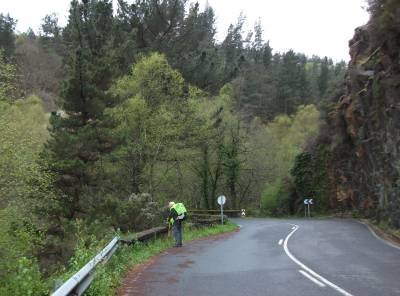I walked the
Camino Frances from late April to the end of May this year. Most of the days were rainy and overcast. We even had snow between Rabanal and Molinaseca (and Crux de Ferro). Several days had road-walking stretches. My advice, incorporating the other good ideas are:
1. Walk on the side of the road FACING traffic. This is opposite for my friends coming from UK Commonwealth nations, Asia and Ireland... ;-)
2. Get a pair of narrow, reflective bicycle safety straps with velcro. This should allow them to be worn on your arms. I used two on one arm (upper and lower) on the side closest to passing vehicles (My right arm). The straps can also be used for anything a velcro strap would be helpful.
3. 3M make a white reflective tape measuring 20 mm wide (3/4"), in small rolls. I got mine at the local DYI store. I cut three pieces about 6 cm (2 1/4") long and applied them to the black plastic twist fittings on each of my Leki walking poles. When the poles are being used, this creates three reflectors about 50 cm (18") apart on the poles. Weighs nothing.
When walking on the a road, as cars approached, I would "flick" my right wrist to cause the pole to swing in an arc perpendicular to the roadway. To an oncoming driver, this would appear as three flashing marks. Unless the driver is simply not looking forward, he/she WILL see the reflectors - and me. It worked every time, in all weather. Trucks and cars moved closer to or over the center line to give me, and my walking companions a wider clearance. Safe, cheap, and light.
4. Seattle Sports makes LED lights that have grippy, stretchy, rubbery mounting slings to attach to seat posts, frames, handlebars, sternum straps, daisy chains, or even heads with any elastic cord. The lights come in red or white and have a solid, slow flash, and quick flash mode. The casing is highly water resistant. Each light weighs 22 grams (0.8 ounces). I added one to each walking pole. One is white and the other is red. They can also be used as (white / red) flashlights or strobe lights. Mine cost USD 7.95, each at REI. This replaces a torch or headlight.
5. Beyond this, always walk single-file. Put the person who is most visible in the front of the queue. That was usually me. Do not bunch together. Leave perhaps 6-7 meters between each person - just in case the unthinkable happens.
Buen Camino
Tom





















